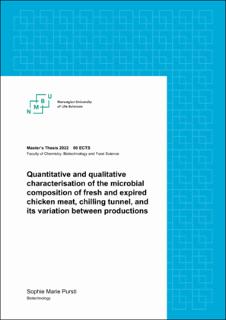| dc.contributor.advisor | Østlie, Hilde | |
| dc.contributor.advisor | Moen, Birgitte | |
| dc.contributor.author | Pursti, Sophie Marie | |
| dc.date.accessioned | 2022-12-12T10:14:27Z | |
| dc.date.available | 2022-12-12T10:14:27Z | |
| dc.date.issued | 2022 | |
| dc.identifier.uri | https://hdl.handle.net/11250/3037205 | |
| dc.description.abstract | Achieving a sustainable future is a complex task, of which reducing food waste is an important facet. The reported food waste in 2019 per capita in Norway was 78 kg, of which 55% was at consumer level. Chicken meat is healthy and sustainable in terms of relative greenhouse gas emissions per kg meat produced. However, chicken is prone to spoilage, despite cold storage and anaerobic modified atmosphere packing (MAP).
This study aimed to characterise the microbial quality and its variation of the output of a Norwegian chicken meat producer, with a long-term goal of predicting the shelf-life of products before packing. To this end skinless chicken breast filets, chicken legs with skin and the surfaces of the production plant’s chilling tunnel were sampled early and late in the production day on the first and fourth day of the production week, over five weeks. The meat samples were analysed after 1 day and 21 days of MAP storage at 4 ºC. Half of the samples stored for 21 days were treated with a 8 ºC temperature abuse for the final four days of the storage time. Environment sample analysis took place, the day of sampling. The microbial quality was analysed quantitatively by traditional microbiology techniques in MAP incubation and qualitatively by MALDI-TOF MS and 16S rRNA gene sequencing.
Pseudomonas and E. coli dominated the fresh chicken microbiota incubated in MAP, and the Lactic Acid Bacteria Carnobacterium and Lactobacillus dominated the expired chicken MAP microbiota. The microbiota of the expired chicken filets was significantly less diverse and developed than that of the expired chicken legs. The chicken filets were not spoiled as per the bacterial load definition of spoiled food (107 CFU/g). Acinetobacter, Psychrobacter and Pseudomonas composed the majority microbiota of the chilling tunnel environment. Qualitative and quantitative variation between production days was seen in all sample groups, particularly with higher microbial levels on Thursdays compared to Mondays.
The low bacterial load on the expired chicken filets implies a longer shelf-life than the expiration date of 19 days post-production. The statistical significance between Mondays and Thursdays in all sample types implies a connection between the product and chilling tunnel surface environment. In conclusion the products put out by the producer are of good and even quality, and more work is needed to understand the causes of quality variation in chicken products. | en_US |
| dc.description.abstract | En del av forutsetningene for en bærekraftig fremtid, er å redusere matsvinn. Rapportert matsvinn i 2019 per innbygger i Norge var 78 kg, hvorav 55 % var på forbrukernivå. Kyllingkjøtt er sunt og bærekraftig målt i relative klimagassutslipp per kg produsert kjøtt, men er utsatt for å forringelse til tross for kjølelagring og anaerob modifisert atmosfærepakking (MAP).
Målet til denne studien var å karakterisere den mikrobielle kvaliteten og dens variasjon av produksjonen til en norsk kyllingkjøttprodusent. Prøver av to kyllingprodukter og overflatene til produksjonsanleggets kjøletunnel ble tatt, tidlig og sent på produksjonsdagen, den første og fjerde dagen i produksjonsuken, over fem uker. Kjøttprøvene ble analysert etter 1 og 21 dager med MAP-lagring ved 4 ºC. Halvparten av prøvene lagret i 21 dager ble utsatt for temperaturavvik på 8 ºC i de 4 siste dagene av lagringsperioden. Miljøprøveanalyse fant sted samme dag som prøvetaking. Den mikrobielle kvaliteten ble analysert kvantitativt ved tradisjonelle mikrobiologiske teknikker i MAP-inkubasjon og kvalitativt med MALDI-TOF MS og 16S rRNA-gensekvensering på genusnivå.
De utgåtte kyllingfiletene var ikke forringet basert på kimtall (<107 CFU/g). Kvalitativ og kvantitativ variasjon mellom produksjonsdager ble sett i alle utvalgsgruppene, med bl.a. høyere mikrobielle nivåer på torsdager enn mandager. Pseudomonas og E. coli dominerte den ferske kyllingmikrobiotaen inkubert i MAP, og Carnobacterium og Lactobacillus dominerte i de utgåtte kyllingprøvenes. Mikrobiotaen til de utgåtte kyllingfiletene var betydelig mindre variert og utviklet enn til de utgåtte kyllinglårene. Lårprøvenes mikrobiota skilte signifikant mellom temperaturbehandlinger. Acinetobacter, Psychrobacter og Pseudomonas utgjorde majoriteten av mikrobiotaen i kjøletunnelmiljøet.
Den lave bakteriemengden på de utgåtte kyllingfiletene innebærer en lengre holdbarhet enn utløpsdatoen på 19 dager etter produksjon. Den statistiske signifikansen mellom mandager og torsdager i alle utvalgstyper antyder en viss sammenheng mellom produktets og kjøletunnelens mikrobiota. Avslutningsvis er produktene som produseres av god kvalitet med lite variasjon og videre arbeid må utføres for å bedre forstå variasjonen i det store bildet. | en_US |
| dc.language.iso | eng | en_US |
| dc.publisher | Norwegian University of Life Sciences, Ås | en_US |
| dc.rights | Attribution-NoDerivatives 4.0 Internasjonal | * |
| dc.rights.uri | http://creativecommons.org/licenses/by-nd/4.0/deed.no | * |
| dc.title | Quantitative and qualitative characterisation of the microbial composition of fresh and expired chicken meat, chilling tunnel, and its variation between productions | en_US |
| dc.type | Master thesis | en_US |
| dc.description.localcode | M-BIOTEK | en_US |

